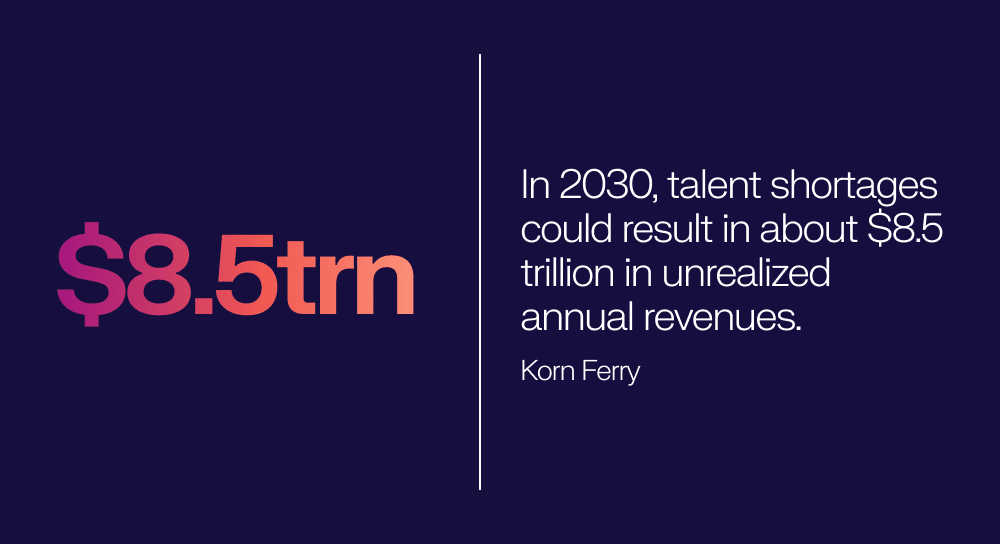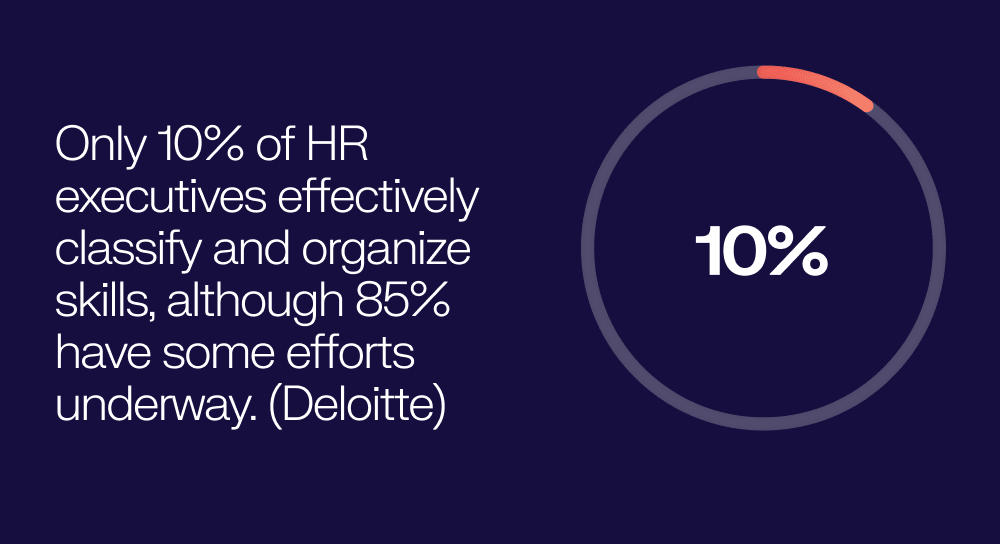Minimizing Talent Risk, Maximizing Success
While businesses respond to a constantly evolving market, and make bids to transform, innovate or enter new markets as technological developments accelerate, they often underestimate the role of talent in their efforts. To put it more negatively: they don’t see how business success, or failure, is impacted by the levels of talent risk in their organizations.
Meeting business commitments – whether that’s revenue targets, successful product launches, customer retention, market expansions, or something else – relies on having the right people in the right roles.
But 60% of businesses say that skills gaps in the local labour market hold back the transformation of their business (World Economic Forum), while nearly 83% of human resources leaders say they struggle to find enough talent with the necessary skills. 57% say skills shortages are undermining their ability to sustain corporate performance. (Gartner)

Unfortunately, addressing talent-related risks – whether that’s people, data about the people, tools being used to allocate resources, or broader strategies relating to people – is often low on the agenda.
So, what do you need to focus on to minimize talent risk, and ensure you meet your business goals?
Proactive Hiring, For Business Success
Hiring top talent is no longer just about filling roles; it’s about securing the skills your organization needs to thrive in the face of rapid change. A reactive approach to recruitment – simply waiting for candidates to apply, and relying on outdated criteria – is no longer sufficient. Companies must adopt proactive hiring strategies that prioritize the candidate experience, and assess people based on what they can (or could) do – not where they’ve worked or studied.
Proactive hiring involves building strong talent communities, nurturing passive talent, and nailing down your employer brand.
By making it easy for potential candidates to register their skills and express interest, you can create a pipeline of qualified talent before a role even opens. The result? Faster, more precise hiring decisions that align perfectly with your business needs.
And a skills-first approach expands the talent pool dramatically. Research shows that talent pools can grow nearly tenfold when organizations focus on skills rather than traditional markers like degrees or prior job titles. This approach also ensures better hiring decisions: skills-based hiring criteria are five times more predictive of job performance than educational background and 2.5 times more predictive than work experience, according to Forrester.
Upskilling & Reskilling, For Future Growth
The skills your organization needs today are likely not the skills it will need tomorrow. In fact, the World Economic Forum estimated that 40% of core skills will change between 2020 and 2025, and automation alone will displace 85 million jobs – while creating 97 million new ones.
This seismic shift in workforce requirements underscores the urgent need for upskilling and reskilling.
Investing in workforce development ensures your organization stays competitive, even as industry demands evolve. This is particularly important in emerging fields like green energy, where the necessary skills may not yet even exist in the labor market. Tailored learning programs can prepare employees for these future roles while addressing current skill gaps.
Employees themselves recognize the need for growth: 58% believe their job requirements will change significantly in the next five years (WEF). Yet many organizations lag behind. A recent Gartner survey revealed that 62% of HR leaders view uncertainty around future skills as a significant risk, and 50% admit their organizations do not effectively leverage the skills they already have.
Addressing this gap requires a deliberate, strategic approach to learning and development that equips employees with both the skills they need now and the agility to adapt to future challenges.
Retention Through Growth and Engagement
Learning and development is one route to holding on to employees (and institutional knowledge) and saving money on external hiring.
Retaining talent is crucial, and it isn’t just about offering competitive salaries – it’s about creating an environment where employees can learn, grow, and thrive. Without these opportunities, even your best employees are likely to leave. Gallup reports that 51% of employees are actively seeking new jobs, with culture, engagement, and work-life balance cited as primary reasons for leaving … far outpacing compensation as a driver of attrition.
A skills-based approach to talent management can dramatically improve retention. Skills-based hires stay with their organizations 9% longer than traditional hires (BCG), and companies that prioritize skills-based decisions are 98% more likely to retain high performers, according to Deloitte.
Additionally, employees who feel their organization values growth are far more likely to remain: 67% of workers say they would stay with a company that offers upskilling and advancement opportunities, even if dissatisfied with their current role. (Korn Ferry)
Retention isn’t just about keeping employees; it’s about keeping them engaged. Low engagement costs the global economy an estimated $8.9 trillion annually (Gallup). By investing in career growth, internal mobility, and skills development, organizations can create a workforce that is not only loyal but also highly productive.
Building a Skills-Based Organization 🧱
A skills-based approach to workforce management is fast becoming a critical strategy for minimizing talent risk and navigating a rapidly changing world and workforce. Indeed, 77% of business and HR executives believe “flexibly moving skills to work” is critical to navigating future disruptions. (Deloitte)
But how can organizations make this shift? Here are three key areas to focus on:
Looking at people and work through the lens of “skills”
Transitioning to a skills-based organization starts with data, and creating a unified, dynamic view of workforce capabilities.
“Having the ability to know what skills you have in your company, the ability to then predict what skills you’re going to need in the future, and filling the gap, is really how your company is going to grow or change or transform.” – Jacqui Canney, Chief People Officer, ServiceNow
This involves developing a robust skills ontology: a framework that maps existing skills, identifies gaps, and aligns them with business goals. Unlike static systems, a skills-based strategy requires constant updates informed by internal and external signals.
This approach drives measurable outcomes: Deloitte found that skills-based organizations are 107% more likely to place talent effectively, 52% more likely to innovate, and 57% more likely to respond efficiently to change. By aligning talent strategies with business needs, organizations can ensure they have the right people in the right roles at the right time.

Learn more about becoming a skills-based organization
Connecting Systems and Workflows
Fragmented HR systems are a major barrier to effective talent management. Many organizations struggle to integrate data across departments, leading to inefficiencies and missed opportunities. A single source of skills data – accessible across the entire workforce – is essential for making informed decisions.
However, few organizations currently achieve this level of integration. 63% of HR executives say they are using “skills-related technology embedded in core HR information systems” – but just 33% say they have a single source of skills data across the entire workforce (Deloitte).
And, among more than 1,200 employees surveyed by Gartner in February 2024, 69% reported experiencing at least one barrier when interacting with HR technology in the past 12 months.
Addressing the issue of disjointed, out-of-date data requires not just better tools, but also a strategic commitment to breaking down silos, and fostering collaboration.
Learn more about uinfying talent data
Leveraging AI for Talent Management
AI is transforming how organizations manage talent, making it easier to predict workforce needs, close skills gaps, and optimize hiring and development.
For example, AI can analyze workforce and labor market data to identify emerging skills trends, enabling proactive planning. It can also personalize learning recommendations, ensuring employees receive training tailored to their unique needs and career goals, or suggest internal moves that would make use of adjacent or transferable skills.
In hiring, AI models can recommend candidates for roles based on skills, rather than traditional criteria, improving both speed and accuracy – as well as fairness.
For workforce planning, AI-powered scenario modeling helps HR leaders simulate the impact of changes, from market expansions to restructuring efforts.
AI also enhances decision-making by transforming fragmented skills data into clear, dynamic insights. By incorporating your organizational data, the best AI models ensure you have the full context around people and jobs at your specific company, and can turn insights into action.
BCG’s research on future-ready companies identified AI as one of six key attributes that help them withstand shocks and disruptions and exploit innovation for value-creating growth.
By incorporating ethical AI into their talent strategies, organizations can achieve the agility and resilience needed to thrive in today’s fast-paced environment.
Learn more about using skills data and AI in talent management.
Make Talent a Strategic Priority
Addressing talent risk is no longer just an HR responsibility – it is a business imperative.
Ninety percent of business leaders agree that transitioning to a skills-based organization will require a transformation across all functions, not just HR. Yet the payoff is immense: aligning talent strategies with business goals enables organizations to minimize risk, capitalize on opportunities, and achieve sustainable growth. Skills-based organizations are 107% more likely to place talent effectively… and 57% more likely to anticipate change and respond effectively and efficiently. (Deloitte)
Keen to avoid talent risk in 2025? Beamery can help you:
- Build a skills-based approach to finding talent and making talent decisions, operationalized across talent ecosystem workflows – with a taxonomy-agnostic single source of truth for skills
- Leverage ethical, explainable AI models – for richer data and better talent-related recommendations – which adapt to your organization, learn and continuously improve
- Understand skills demand requirements related to your organizational plan/strategy
- Turbocharge the job of finding talent, enabling you to complete your plan, with talent guided to the most critical roles and able to discover jobs relevant to their skills that they may not have otherwise thought of or found
- Connect data and systems to bring insights into the flow of work, and integrate skills intelligence with with your human capital systems (such as Workday and SAP).
By adopting a proactive approach to hiring, investing in workforce development, and leveraging the right AI and technology, organizations can build a resilient, future-ready workforce. The question is not whether you can afford to address talent risk – it’s whether you can afford not to.